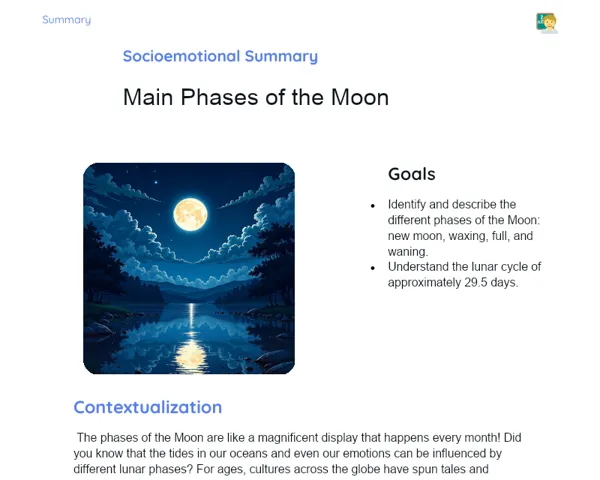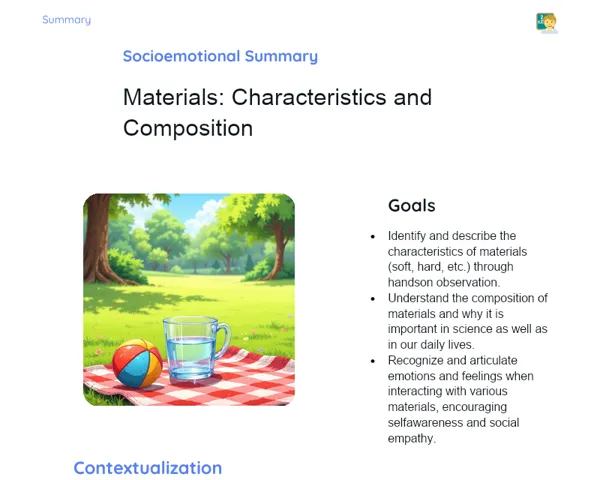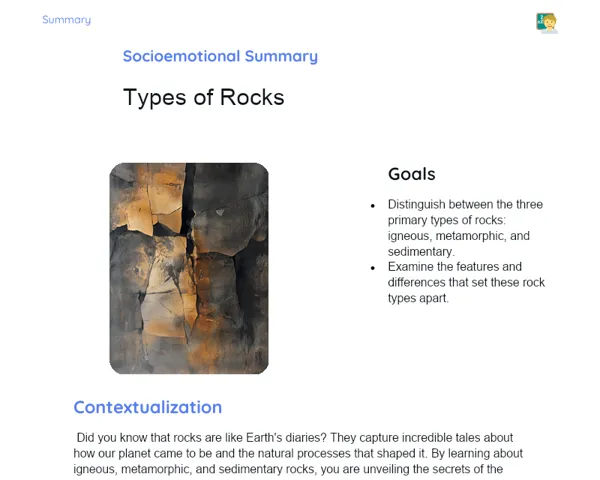Summary Tradisional | Mixtures: Introduction
Contextualization
Mixtures are combinations of two or more substances that come together without creating a new substance. We encounter these mixtures in various aspects of our daily lives—like the air we breathe, the food we share with loved ones, and the water we use for drinking and cooking. Broadly, there are two types of mixtures: homogeneous and heterogeneous. Homogeneous mixtures have a consistent appearance, where the individual components are not easily spotted, while heterogeneous mixtures allow us to see and identify the different components that make them up.
In the realm of science, grasping the difference between these mixture types is crucial for understanding how substances interact and how they can be separated. For instance, pulp-free orange juice is a classic example of a homogeneous mixture because all its components are completely dissolved and blend uniformly. Conversely, a colourful fruit salad represents a heterogeneous mixture, where we can clearly spot and pick out each piece of fruit. Familiarizing ourselves with these concepts enhances our appreciation of the role mixtures play in everyday activities and various scientific undertakings.
To Remember!
Concept of Mixture
A mixture is formed by blending two or more substances that do not chemically react to create a new substance. Mixtures are prevalent in our day-to-day experience, found in many forms—from the air we breathe to the food we eat. The key feature of a mixture is that each component retains its own properties and can be separated by physical processes.
Mixtures can primarily be classified into two categories: homogeneous and heterogeneous. This classification is based on the visual uniformity of the mixture's components. In homogeneous mixtures, the components are thoroughly mixed and cannot be easily distinguished, while heterogeneous mixtures are those where the components can be distinctly observed.
Grasping the concept of mixtures is a foundational step in science since we frequently need to separate or identify the individual components in labs and industries. Recognizing and categorizing mixtures is also handy in daily life, easing tasks like preparing meals or cleaning up.
-
A mixture is formed by blending two or more substances without forming a new substance.
-
The components in a mixture retain their respective properties.
-
Mixtures can be categorized as either homogeneous or heterogeneous.
Homogeneous Mixtures
Homogeneous mixtures are those where the components are fully dissolved, making it difficult to distinguish them visually. These mixtures possess a uniform appearance, ensuring that any sample taken from it exhibits the same composition. Common examples include solutions like sugar water, air, and pulp-free orange juice.
A noteworthy trait of homogeneous mixtures is that all components exist in a single phase. For instance, in sugar water, both substances are in liquid form. This consistency makes it easier to study and identify these mixtures and apply suitable separation techniques, like evaporation to extract salt from saltwater.
Understanding homogeneous mixtures is vital across various scientific fields and engineering, particularly in chemistry, where making homogeneous solutions is routine. Additionally, many everyday products, from drinks to medicines, fall under the category of homogeneous mixtures, underlining their practical significance.
-
Homogeneous mixtures exhibit a uniform appearance.
-
Components of homogeneous mixtures exist in the same phase.
-
Examples include sugar water and air.
Heterogeneous Mixtures
Heterogeneous mixtures are composed of components that are visually distinguishable. This means that, upon examining the mixture, one can separately identify each substance present. Classic examples include fruit salad, sand mixed with water, and oil combined with water.
A defining characteristic of heterogeneous mixtures is that they contain more than one phase, such as the coexistence of solids and liquids. For example, in a sand and water mixture, the sand (a solid) settles at the bottom, while the water (a liquid) rests above it. This visual separation aids in using physical separation methods, like filtration and decantation.
Comprehending heterogeneous mixtures is crucial for both industrial and laboratory applications, where separating components is often needed. It's also beneficial in our daily lives, helping us organize and prepare food, like sorting the ingredients in a salad.
-
Heterogeneous mixtures have components that can be visually differentiated.
-
There's a presence of multiple phases, such as solids and liquids.
-
Examples include fruit salad and sand mixed with water.
Methods of Separation of Mixtures
Methods of separating mixtures are techniques employed to isolate the different components based on their physical properties. Various methods suited to particular types of mixtures exist. Some common ones include filtration, decantation, and evaporation.
Filtration is effective in separating solid components from liquids in heterogeneous mixtures. For instance, when filtering a sand and water mixture, the sand gets trapped in the filter, while the water flows through. Decantation involves separating immiscible liquids or letting solids settle in a liquid. In an oil and water mixture, decantation permits the less dense oil to rise above the water. Evaporation is used to isolate a solid solute from a liquid solvent in homogeneous mixtures, such as extracting salt from saltwater.
Understanding these separation methods is essential for scientific, industrial, and everyday activities. It facilitates the purification of substances and the recovery of valuable components while enabling more precise execution of scientific experiments.
-
Separation methods are based on the physical properties of substances.
-
Some common methods are filtration, decantation, and evaporation.
-
These methods are crucial for scientific, industrial, and everyday processes.
Key Terms
-
Mixture: The combination of two or more substances without creating a new substance.
-
Homogeneous: A mixture with a uniform appearance, where components are not visibly distinguishable.
-
Heterogeneous: A mixture where components are visually distinct and may exist in different phases.
-
Filtration: A method used to separate solid particles from liquids in heterogeneous mixtures.
-
Decantation: A separation technique that uses differences in density to separate immiscible liquids or solids from liquids.
-
Evaporation: A method that removes a liquid solvent to concentrate or isolate a solid solute.
Important Conclusions
The lesson on mixtures introduced vital concepts of homogeneous and heterogeneous mixtures, shedding light on their key characteristics and distinctions. Homogeneous mixtures maintain a uniform appearance, where individual components can't be detected, while heterogeneous mixtures allow us to see their distinct parts. Practical examples like pulp-free orange juice and fruit salad effectively illustrated these concepts in an engaging manner.
Moreover, we explored several methods of separating mixtures—like filtration, decantation, and evaporation. These techniques are crucial across science and industry, enabling the separation and purification of various mixture components. Grasping these processes is vital for numerous daily and professional activities, making tasks like food preparation or cleaning more efficient.
In conclusion, appreciating the relevance of studying mixtures underscores how this knowledge is applied in our daily lives and across diverse scientific domains. Understanding how mixtures form and can be separated helps us comprehend the world around us better and recognize the significance of every component in the substances we utilize.
Study Tips
-
Review the concepts of homogeneous and heterogeneous mixtures, using relatable examples from your daily life to aid your understanding.
-
Practice identifying mixtures within your home, classifying them as homogeneous or heterogeneous, and considering feasible separation methods.
-
Delve deeper into separation techniques like filtration and decantation, trying out small supervised experiments whenever possible.



